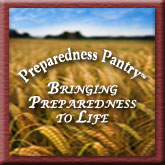26 Weeks to Family Emergency Preparedness
WEEK ACTION TO TAKE
1 Get a portable container with a lid to use as an emergency kit. A plastic storage bin or garbage can works well, particularly one with wheels. Choose an accessible location for the container near an exit, and label the container. Make sure all family members know what it will be used for and where it is.
2 Stock your kit with a three-day supply of water, and don't forget to include water for your pets. You need four litres of water per person per day - two for drinking and two for food preparation and hygiene.
3 Arrange an out-of-area phone contact person, and keep this and other emergencyphone numbers near each telephone. Teach each family member these numbers.
4 Stock your kit with several varieties of canned meat and dried fruit. Include a manual can opener.
5 Get a portable radio and extra batteries for your emergency kit.
6 Learn about hazards. Find out what the hazards are in your community, and do a home hazard hunt to make your home safer. Secure appliances and heavy furniture, and move beds away from heavy mirrors and windows.
7 Give every family member specific safety tasks to do in an emergency. For example, designate one person to be in charge of turning off elect ricity, one to collect the emergency container, one to take charge of any pets, etc. Add peanuts and granola bars to your kit.
8 Identify safe places in your home and on your property. Plan and practice evacuation drills using two different escape routes from each room. Add containers of juice or juice crystals to your kit.
9 Stock your kit with both large and medium-sized plastic garbage bags (orange oryellow make good visible signals). Large bags can also be used as ponchos, ground covers or blankets. Add plastic or paper dishes.
10 Identify a family meeting place away from home but close to your regular spots (between work and home or school). Add some books, toys and cards to your kit.
11 Add a flashlight and extra batteries, along with candles and waterproof matches.
12 Add some dried soups, crackers and peanut butter to your emergency kit.
13 Check your insurance policies and make records of your possessions.
14 Prepare a first-aid kit that includes extra prescription medication, extra eyeglasses,bandages, sterile gauze pads, tape, scissors, tweezers, antibiotic ointment, hydrogen peroxide and over-the-counter pain pills.
15 Add a change of clothing for each family member to your kit. Be sure to include warm clothing, heavy work gloves and sturdy shoes.
16 Add some canned food like stews, baked beans and vegetables to your kit.
17 Enroll a family member in a first-aid course.
18 Add personal toiletry items like toilet paper, handy wipes, soap, detergent,toothbrush, toothpaste, comb, sanitary supplies, etc. to your emergency kit.
19 Add evaporated canned or powdered milk and cereal to your kit.
20 If needed, include infant supplies including disposable diapers, disposable bottles, formula, etc. to your emergency kit.
21 Get a large bucket with a tight-fitting lid to use as a toilet, and put it with your emergency kit. Use the bucket to store other emergency tools like an axe, a folding shovel and rope.
22 Add some freeze-dried or foil pouch food products like meats, soups, vegetables and stews.
23 Add a pocket knife (Swiss army style), cutlery, a whistle and spare set of house and car keys to your container.
24 Keep a leash or pet carrier near your kit and add a three-day supply of pet food.
25 Add sleeping bags or blankets to your kit along with water purification tablets.
26 Assemble important documents like wills, insurance papers, medical records, inventory of possessions, identification, etc. in a fireproof/waterproof container. Add a family photo album to your emergency kit.
Friday, September 11, 2009
Subscribe to:
Post Comments (Atom)



No comments:
Post a Comment